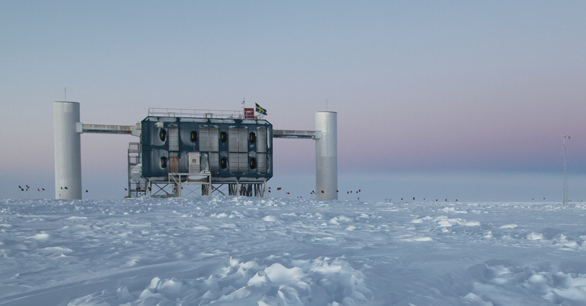projects
ICECUBE

Overview
The IceCube Neutrino Observatory is a particle detector at the South Pole that records the interactions of a nearly massless subatomic particle called the neutrino. IceCube searches for neutrinos from the most violent astrophysical sources—events like exploding stars, gamma-ray bursts, and cataclysmic phenomena involving black holes and neutron stars. In 2013, IceCube made headlines with its breakthrough discovery of neutrinos of astrophysical origin. IceCube continues its mission to understand the sources of these mysterious messengers from outer space. This includes a vigorous multiwavelength program supported by IceCube members who also do research in gamma-ray astronomy.
IceCube also studies the neutrino itself. With its low-energy extension, DeepCore, IceCube covers an energy range from ten GeV to PeV. It measures the atmospheric neutrino spectrum from the lower energies where neutrinos oscillate to energies as large as 100 TeV, with a statistic of more than 100,000 events per year. IceCube measures the atmospheric oscillation parameters in an energy range one order of magnitude higher than other experiments, thus opening a new window on neutrino physics. Other priorities include the observation of the next Galactic supernova and the search for dark matter. Multiple search strategies for dark matter have resulted in world-best limits on the interaction cross section of dark matter with ordinary matter in large classes of models.
IceCube collects a large number of cosmic ray induced events, as well. Their energy, mass composition and arrival direction distributions are measured to infer their propagation properties through interstellar medium and the heliosphere.
Research Topics
- Characterization of cosmic neutrino flux
- Neutrino particle physics from atmospheric neutrino oscillations; search for sterile neutrinos and neutrino physics beyond the Standard Model
- Origin of cosmic rays, measurements of spectrum and composition in the energy region between the “knee” and the “ankle” in the spectrum
- Detection of neutrino bursts from galactic supernovae
- Search for dark matter
- Development of a next-generation neutrino telescope
Senior Personnel
WIPAC Contributions
WIPAC has the primary responsibility for IceCube maintenance and operations through a coorperative agreement with NSF. UW–Madison personnel work closely with the IceCube Collaboration on all aspects of detector operations and maintenance. Early on, personnel contributed substantially to the sensor design, construction, and installation for IceCube construction. Major construction was completed in December 2010, and regular operation with the full detector started in May 2011.
Recent scientific analyses have focused on point sources and the search for and discovery of a diffuse flux of cosmic neutrinos, all-flavor atmospheric neutrino flux, supernova detection, cosmic ray anisotropies, neutrino oscillations, sterile neutrinos, and PeV gamma rays.
Personnel also contribute to both detector maintenance and operations and data analysis. These efforts include simulations, modeling ice properties, laboratory characterization of the optical sensors, and creating and improving tools that have increased sensitivity of the instrument with each year. We are also involved in the optimization of drilling and the enhancement of the digital optical sensors and data systems for a next-generation detector.
Select Publications
Searches for Sterile Neutrinos with the IceCube Detector
IceCube Collaboration: M. G. Aartsen et al
(Journal Article) Physical Review Letters 117 (2016) 071801; e-print archive arXiv:1605.01990 [astro-ph.HE]
journals.aps.org | arxiv.org
Evidence for Astrophysical Muon Neutrinos from the Northern Sky with IceCube
IceCube Collaboration: M. G. Aartsen et al
(Journal Article) Physical Review Letters 115 (2015) 081102; e-print archive arXiv:1507.04005 [astro-ph.HE]
journals.aps.org | arxiv.org
Evidence for High-Energy Extraterrestrial Neutrinos at the IceCube Detector
IceCube Collaboration: M. G. Aartsen et al
(Journal Article) Science 342 (2013) 1242856, 22 November 2013; DOI: 10.1126/science.1242856
sciencemag.org | sciencemag.org | arxiv.org
First Observation of PeV-energy Neutrinos with IceCube
IceCube Collaboration: M. G. Aartsen et al
(Journal Article) Physical Review Letters 111 (2013) 021103; e-print archive arXiv:1304.5356 [astro-ph.HE]
prl.aps.org | arXiv.org
